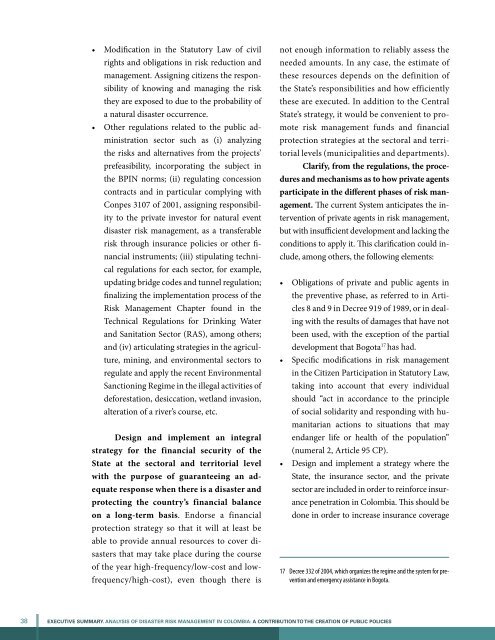Executive Summary - GFDRR
Executive Summary - GFDRR
Executive Summary - GFDRR
You also want an ePaper? Increase the reach of your titles
YUMPU automatically turns print PDFs into web optimized ePapers that Google loves.
• Modification in the Statutory Law of civil<br />
rights and obligations in risk reduction and<br />
management. Assigning citizens the responsibility<br />
of knowing and managing the risk<br />
they are exposed to due to the probability of<br />
a natural disaster occurrence.<br />
• Other regulations related to the public administration<br />
sector such as (i) analyzing<br />
the risks and alternatives from the projects’<br />
prefeasibility, incorporating the subject in<br />
the BPIN norms; (ii) regulating concession<br />
contracts and in particular complying with<br />
Conpes 3107 of 2001, assigning responsibility<br />
to the private investor for natural event<br />
disaster risk management, as a transferable<br />
risk through insurance policies or other financial<br />
instruments; (iii) stipulating technical<br />
regulations for each sector, for example,<br />
updating bridge codes and tunnel regulation;<br />
finalizing the implementation process of the<br />
Risk Management Chapter found in the<br />
Technical Regulations for Drinking Water<br />
and Sanitation Sector (RAS), among others;<br />
and (iv) articulating strategies in the agriculture,<br />
mining, and environmental sectors to<br />
regulate and apply the recent Environmental<br />
Sanctioning Regime in the illegal activities of<br />
deforestation, desiccation, wetland invasion,<br />
alteration of a river’s course, etc.<br />
Design and implement an integral<br />
strategy for the financial security of the<br />
State at the sectoral and territorial level<br />
with the purpose of guaranteeing an adequate<br />
response when there is a disaster and<br />
protecting the country’s financial balance<br />
on a long-term basis. Endorse a financial<br />
protection strategy so that it will at least be<br />
able to provide annual resources to cover disasters<br />
that may take place during the course<br />
of the year high-frequency/low-cost and lowfrequency/high-cost),<br />
even though there is<br />
not enough information to reliably assess the<br />
needed amounts. In any case, the estimate of<br />
these resources depends on the definition of<br />
the State’s responsibilities and how efficiently<br />
these are executed. In addition to the Central<br />
State’s strategy, it would be convenient to promote<br />
risk management funds and financial<br />
protection strategies at the sectoral and territorial<br />
levels (municipalities and departments).<br />
Clarify, from the regulations, the procedures<br />
and mechanisms as to how private agents<br />
participate in the different phases of risk management.<br />
The current System anticipates the intervention<br />
of private agents in risk management,<br />
but with insufficient development and lacking the<br />
conditions to apply it. This clarification could include,<br />
among others, the following elements:<br />
• Obligations of private and public agents in<br />
the preventive phase, as referred to in Articles<br />
8 and 9 in Decree 919 of 1989, or in dealing<br />
with the results of damages that have not<br />
been used, with the exception of the partial<br />
development that Bogota 17 has had.<br />
• Specific modifications in risk management<br />
in the Citizen Participation in Statutory Law,<br />
taking into account that every individual<br />
should “act in accordance to the principle<br />
of social solidarity and responding with humanitarian<br />
actions to situations that may<br />
endanger life or health of the population”<br />
(numeral 2, Article 95 CP).<br />
• Design and implement a strategy where the<br />
State, the insurance sector, and the private<br />
sector are included in order to reinforce insurance<br />
penetration in Colombia. This should be<br />
done in order to increase insurance coverage<br />
17 Decree 332 of 2004, which organizes the regime and the system for prevention<br />
and emergency assistance in Bogota.<br />
38 EXECUTIVE SUMMARY. ANALYSIS OF DISASTER RISK MANAGEMENT IN COLOMBIA: A contribution TO the creation of public policies

















